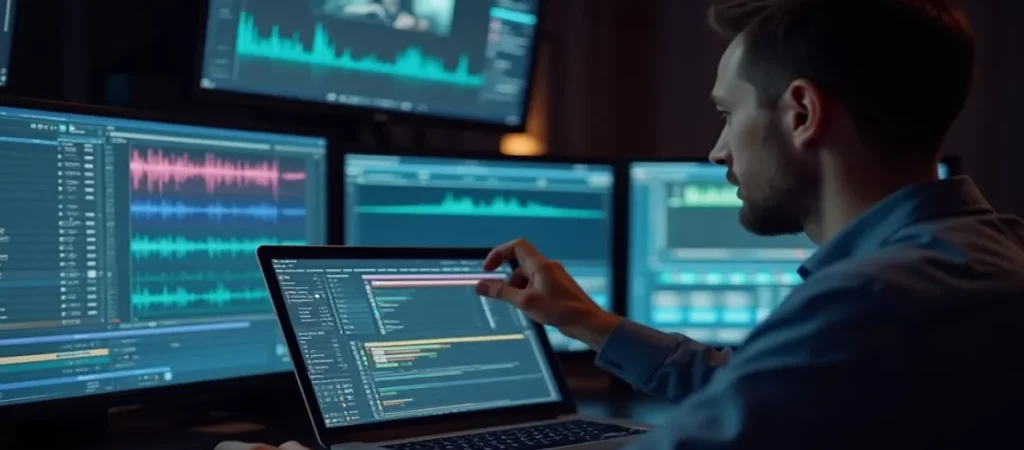Transcription and captioning have become crucial in today’s digital broadcasting landscape for different reasons. Captioning primarily fulfills legal requirements to ensure content is accessible to individuals with hearing impairments. At the same time, transcription serves broader business goals, such as improving content searchability and unlocking new monetization opportunities. As the demand for media content grows, broadcasters must embrace both tools to meet accessibility standards and optimize their content for internal and external use.
By providing captions, broadcasters adhere to regulations like the Americans with Disabilities Act (ADA) and the Communications and Video Accessibility Act (CVAA), ensuring their content is accessible to all viewers. On the other hand, transcription enhances operational efficiency, making content easier to search, categorize, and repurpose. Thus, it unlocks revenue streams through improved discoverability and repackaging for different platforms.
The Shift Towards Accessible Content
In broadcasting, making content accessible is a necessity, but it’s not just about compliance. Captions are pivotal in making media content accessible to those with hearing impairments or language barriers. Transcriptions, meanwhile, provide additional benefits, enabling broadcasters to speed up their content search process and better manage their media archives. The ability to quickly find specific content within hours of footage streamlines workflows and enhances the potential for repurposing and monetizing content.
Broadcasters who fail to provide accessible content through captions risk alienating significant portions of their audience. Those who overlook transcription may miss opportunities to improve internal operations and capitalize on existing content. In an increasingly competitive media environment, broadcasters must integrate transcription and captioning workflows to remain relevant, accessible, and efficient.
How TranceIQ Helps
TranceIQ transforms how broadcasters manage transcription and captioning by providing a seamless, automated solution that enhances efficiency and accuracy. Here’s how TranceIQ can help your media production:
- Automated Transcription: Drastically reduce time spent on manual transcription and captioning with automated processes.
- Real-Time Monitoring: Ensure accuracy and compliance with legal standards through live monitoring of transcriptions and captions.
- Customizable Workflows: Scale your operations with flexible workflows tailored to handle content volume or specific production needs.
- Editing Tool Integration: Streamline your post-production process by integrating transcription and captioning directly into popular editing software.
Improve your transcription and captioning workflows. Schedule a demo today to see how TranceIQ can boost your media production efficiency!
Captioning: Meeting Legal and Regulatory Requirements
Captioning is critical for broadcasters to comply with various accessibility laws. In the United States, laws like the ADA and CVAA require broadcasters to provide accurate captions for all video content to ensure it is accessible to viewers with hearing impairments. Similar laws exist globally, such as the European Union’s Audiovisual Media Services Directive (AVMSD) and Australia’s Disability Discrimination Act, which emphasize the need for captions in broadcast media.
Compliance with these regulations protects broadcasters from fines and legal consequences but demonstrates a commitment to accessibility and inclusivity. By investing in efficient captioning workflows, broadcasters meet legal standards and signal to audiences worldwide that they are committed to making their content accessible to all.
Transcription: Enhancing Searchability and Monetization
Unlike captioning, transcription is not just about accessibility. It is a powerful tool for broadcasters to organize, search, and monetize their content more effectively. With detailed transcriptions, broadcasters can index their media, making it easier to search for specific segments. This functionality accelerates workflows and improves content management, allowing production teams to locate footage and reuse it in future projects quickly.
Additionally, transcription enables broadcasters to repurpose their content for different platforms and markets, opening new revenue streams. Whether repackaging content for international audiences or creating new products from existing footage, transcription helps broadcasters monetize their archives, creating opportunities for long-term profitability.
Expanding Beyond U.S. Regulations
While U.S. laws like the ADA and CVAA govern captioning requirements, similar regulations exist worldwide. For example, in the European Union, the AVMSD mandates that media providers ensure accessibility through captioning, especially for public service broadcasters. Similarly, Australia’s Disability Discrimination Act requires captions for television and other media platforms to ensure equal access for people with disabilities.
By addressing captioning regulations globally, broadcasters can ensure compliance within the U.S. and in international markets. Meanwhile, with its ability to enhance searchability and improve content reuse, transcription offers universal benefits supporting domestic and international broadcasting efforts.
Challenges in Traditional Transcription and Captioning Processes
Despite the benefits, traditional transcription and captioning processes must be improved to increase efficiency and workflow.
Time-Consuming and Error-Prone Tasks
Manually transcribing or captioning video content is both time-consuming and prone to errors. It can take hours for a human transcriber to process just one hour of footage, leading to delays in content delivery. Furthermore, manual transcription introduces the potential for mistakes, such as misheard words or typographical errors, which can negatively affect the quality of the final content.
These delays and inaccuracies can result in a lower-quality viewer experience and potentially costly rework. As deadlines tighten and production timelines shorten, the inefficiencies of manual transcription become more apparent.
Lack of Workflow Efficiency
Traditional transcription methods often need more integration with other production tools, creating workflow inefficiencies. For instance, transcribers may need to switch between multiple software platforms, resulting in bottlenecks and slowdowns. This disjointed approach to media production affects overall productivity, leading to delays and decreased output.
A disorganized workflow can create further complications, as miscommunications and mismatches between tools lead to errors that could have been avoided with a more streamlined process.
The Role of Automation in Enhancing Transcription and Captioning Efficiency
Automation solves the inefficiencies of manual transcription and captioning by speeding up production timelines and reducing errors.
Speeding Up Production Timelines
Automated transcription systems can quickly process vast amounts of content, which is essential for broadcasters working under tight deadlines. Automated solutions allow transcription and captioning tasks to be completed in a fraction of the time it would take manually, enabling faster content availability.
For broadcasters, this means that content can be delivered to audiences much more quickly, allowing them to meet tight production schedules and keep up with demand.
Reducing Human Error
Automation significantly reduces the risk of errors common in manual transcription. Automated tools are highly accurate, converting spoken words into text with precision. This minimizes errors caused by human fatigue or misinterpretation, ensuring high-quality transcriptions and captions.
This improvement in accuracy leads to better viewer experiences, as captions and transcriptions are precise and reliable, fostering trust in the broadcaster’s content.
Key Components of a Seamless Transcription and Captioning Workflow
To fully reap the benefits of automation, broadcasters must ensure their transcription workflows are seamlessly integrated with other media production processes.
Integration with Editing Tools
An effective transcription workflow should integrate seamlessly with popular video editing tools. This integration allows editors to work more efficiently, as they can access and edit transcripts and captions within their video editing software. Features like time-coded transcripts enable editors to make precise cuts and adjustments based on the dialogue or narration in the content.
This streamlined process saves time and ensures greater precision, producing a more polished final product.
Workflow Customization and Scalability
Broadcasters need customizable and scalable workflows to meet their unique production needs. Whether the broadcaster works on a small project or produces large-scale live events, tailoring workflows to specific requirements is crucial. Scalable workflows are essential to handle varying volumes of content and keep up with demand.
Customizing workflows also allows broadcasters to address specific requirements, such as different captioning formats or CMS integrations, making their media production process more adaptable and efficient.
Optimizing Media Workflows for Real-time Transcription and Captioning
Real-time transcription and captioning solutions are vital for live events, where content needs to be immediately accessible.
Instant Content Accessibility
With real-time transcription and captioning, content becomes accessible as it is broadcast. This immediacy is critical for live events, including sports and news broadcasts. Real-time captioning ensures content reaches a broader audience instantly, enhancing the viewer experience and maintaining accessibility standards.
Broadcasters who offer real-time captioning can reach audiences who would otherwise be unable to engage with the content, improving inclusivity and engagement.
Real-Time Monitoring and Adjustments
Real-time solutions also allow broadcasters to monitor and adjust captions on the fly. This capability ensures greater accuracy, especially in fast-paced, live environments with constant changes. Real-time monitoring will enable broadcasters to maintain consistency and quality throughout the broadcast.
This ensures that live content is both accurate and accessible, even in situations where last-minute adjustments are necessary.
Ensuring Accuracy and Consistency in Transcription and Captioning
Maintaining high accuracy and consistency in transcription and captioning is crucial for broadcasters to meet quality standards.
Continuous Monitoring for Quality Control
Automated transcription systems should be continuously monitored to ensure ongoing accuracy. Regular reviews and evaluations of transcriptions and captions help identify discrepancies and ensure that quality remains consistent across all broadcasts.
These quality control measures are essential for maintaining the broadcaster’s reputation and ensuring their content meets audience expectations.
Regular Updates to Lexicons and Style Guides
Regularly updating lexicons and style guides helps broadcasters ensure that their transcriptions and captions remain relevant and accurate. Industries with specialized jargon or rapidly evolving terminology can benefit from up-to-date lexicons that reflect current language trends.
This attention to detail ensures that captions are accurate, even when dealing with highly technical or niche content, maintaining the broadcaster’s credibility.
Integrating Transcription and Captioning into Post-Production Workflows
Integrating transcription and captioning into post-production workflows streamlines processes and enhances the overall quality of media content.
Enhancing Searchability of Media Content
Transcriptions provide a searchable text record of video content, making it easier to locate specific segments in hours of footage. This is particularly useful for archival purposes or repurposing content for new projects. Enhanced searchability allows editors and producers to efficiently retrieve and use media content without wasting time.
This functionality improves the efficiency of post-production teams and enhances their ability to reuse and repurpose content.
Smoother Editing Processes
With time-coded transcriptions, editors can navigate footage more precisely, making cuts and adjustments more efficiently. This streamlined process saves time and reduces the chance of errors, leading to a higher-quality final product.
A smooth editing process ensures the final content is polished, professional, and ready for distribution to audiences.
How Monitoring Systems Can Support Seamless Workflow Integration
Broadcast monitoring solutions such as MonitorIQ ensure seamless transcription and captioning integration. These systems enable broadcasters to monitor transcriptions and captions in real-time, ensuring that content meets regulatory standards.
MonitorIQ helps broadcasters detect discrepancies and make necessary adjustments to maintain content quality and compliance. This proactive approach to monitoring allows broadcasters to deliver consistent, high-quality content.
Preparing for the Future: Scalability and Evolving Needs
As demand for media content increases, broadcasters need scalable transcription workflows that adapt to their evolving needs.
Planning for Higher Volumes of Content
Scalable transcription workflows are essential for broadcasters to manage growing volumes of content efficiently. Broadcasters should invest in systems that can handle higher output without compromising quality or accuracy.
This ensures broadcasters can keep up with the demand for new content while maintaining the high standards their audience expects.
Adapting to New Formats and Languages
As the media landscape evolves, broadcasters must be able to adapt to new formats and languages. This includes handling content in emerging technologies like virtual reality (VR) and augmented reality (AR) and supporting multiple languages for global audiences.
Adapting transcription and captioning workflows to meet these challenges ensures broadcasters remain competitive and inclusive in a rapidly changing industry.
Conclusion
The seamless integration of transcription and captioning workflows offers broadcasters numerous benefits, including enhanced content accessibility, improved workflow efficiency, and compliance with legal standards. By investing in optimized transcription processes, broadcasters can enhance the quality of their content while meeting the needs of diverse audiences.
In an industry where content demands are constantly growing, broadcasters prioritizing seamless integration are better equipped to meet future challenges. This proactive approach improves current operations and future-proofs the broadcaster’s ability to create accessible and inclusive content.
Digital Nirvana: Empowering Knowledge Through Technology
Digital Nirvana stands at the forefront of the digital age, offering cutting-edge knowledge management solutions and business process automation.
Key Highlights of Digital Nirvana –
- Knowledge Management Solutions: Tailored to enhance organizational efficiency and insight discovery.
- Business Process Automation: Streamline operations with our sophisticated automation tools.
- AI-Based Workflows: Leverage the power of AI to optimize content creation and data analysis.
- Machine Learning & NLP: Our algorithms improve workflows and processes through continuous learning.
- Global Reliability: Trusted worldwide for improving scale, ensuring compliance, and reducing costs.
Book a free demo to scale up your content moderation, metadata, and indexing strategy for your media assets with minimal effort and get a firsthand experience of Digital Nirvana’s services.
FAQs:
1. Why are transcription and captioning important in broadcasting?
Transcription and captioning are essential for making media content accessible to everyone, including people with hearing impairments or those who speak different languages. They also help broadcasters comply with legal regulations and improve audience engagement by ensuring inclusivity.
2. What challenges do traditional transcription methods present?
Traditional transcription methods are time-consuming and prone to errors. Manual processes can take hours, often resulting in mistakes that delay content production and lower the quality of captions and transcriptions.
3. How does automation improve transcription and captioning processes?
Automation speeds up the transcription process by quickly converting spoken words into text. It reduces human errors, enhances accuracy, and allows broadcasters to meet tight production deadlines while delivering high-quality content.
4. What benefits come from integrating transcription and captioning workflows with editing tools?
The integration allows editors to access and edit captions and transcripts directly within their video editing software, improving workflow efficiency and ensuring precise cuts and adjustments based on the dialogue or narration in the content.
5. How can broadcasters prepare for future content demands with transcription workflows?
By adopting scalable transcription workflows, broadcasters can efficiently handle larger volumes of content. Regularly updating lexicons and style guides ensures that transcriptions remain accurate and relevant, even as the industry evolves.




